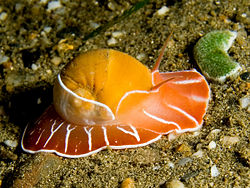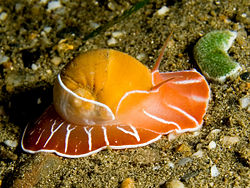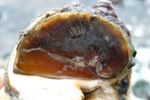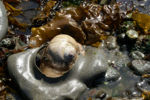Northern moon snail
| Northern moon snail |
|---|

|
| Scientific Classification |
|
| Binomial Name |
|
Polinices heros |
The Northern moon snail (Polinices heros) a predatory marine Gastropod of Mollusks, which range in size from 3.8 - 12.7 cm. Usually the moon snail's shell is brown or a kind of brownish-gray color, but moon snails come in many colors and sizes. [1]
The moon snail is often admired and appreciated because of their exceptional way of reproducing. Many people, if they go out by the beach and on the shore, will see their egg cases lying on the moist sand. [2]
When the moon snail is submerged into the water, they impel the water surrounding them into their mantle and foot. This way, the snail's body increases by about 3 to 4 times compared to its regular size. But when it feels pressured, it will force the water out of its mantle and foot and bring themselves back into the safety of its shell. [3]
An interesting fact about moon snails is that when they die and eventually deteriorate from its shell, hermit crabs will come and take over these shells as homes. The hermit crab will not attack or drive out the snail from its home, but will wait until the moon snail has left and seizes it for himself.[4]
Anatomy
The anatomy of a slow-moving, moon snail is made up of three notable parts. They consist of their body, foot, and mantle. The snail's body is positioned above the foot and simply contains the heart and all the interior organs. The foot is made up of muscle tissue and is located on the bottom of the moon snail. This is the part of the snail that we most often see when we get the chance. The mantle covers the snail's body. In most snails, the mantle produces the shell in which the snail lives in. The systems of the moon snail work best in water because they are aquatic animals. [5]
In the body, the heart pushes the blood into body cavities called sinuses. There the blood washes over the organs. As blood is doing this, other blood is depleted into vessels and then is transferred to the snail's gills. There in the gills, the blood is revived with oxygen.[6]
More interesting facts about the foot is that it is the component of the snail that is the most observed by humans. The snail uses this to glide over surfaces, burrow into the ground, and to wrap around their prey. The foot secretes many different kinds of chemicals and mucuses that allow the moon snail to perform tasks such as eating and reproducing. For eating, the snail's foot creates a chemical that weakens their prey's shell and makes it easier for the snail to drill. For reproducing, the foot molds the sand collar, used to hold the eggs, with sand from the beach and the mucus from its foot. [7]
The two other functions that the moon snail has are the operculum and the radula. The operculum is the "lid" that closes up when the snail withdraws into its own shell. The snail will literary squirt out the water held within the foot and sucks it all into the shell. The operculum will then appear, seemingly from out of the blue, and close up the snail's armor. [8]
The creature's radula is the mouthpart of a moon snail that is like a tongue with sharp teeth used to "drill" holes into the shells of clams and other mollusks, or to the snail, its food. [9]
Reproduction
The reproduction of a moon snail is distinctive. First, the female lays its eggs in a sand collar. It is made by one layer of sand, a layer of eggs, then another layer of sand, and is all held together by the snail's mucus. [10] The sand that helps form the collar preserves the circular shape of it. The moon snail's mucus is molded by their foot and takes the sand collar's round form. The snail keeps the collar from connecting so it appears incomplete. When the collar is first made, it appears to be alive and stands out. But when it washes up on the beach, it dries up and turns weak and flimsy. After the larva is then joined with the sand collar and after they have finished going through their stages, they become small moon snails. [11] Spring through fall, the eggs are arranged and positioned. In about six weeks, the eggs will produce and around 100,000 will hatch. [12]
Ecology
The range that the moon snail can be found in, is the Gulf of St. Lawrence, down to New Brunswick, and even towards North Carolina. They make their homes in the sand at low tide. Existing snails are witnessed digging into the beach floor, where they live. [13] That is why most people don't get to see the actual snail and its foot, but instead they notice the shell of the moon snail. They do this when their body is too immense to fit back inside its shell. So to protect themselves, they burrow into the sand to keep from being eaten. [14]
Along with residing in the damp earth, in between the high tide and low tide, moon snails will also be within water up to 366 meters, or 1200 feet. Down in the southern area in the creature's region, it will settle into a more subterranean part of the ocean. [15] The moon snail will inhabit deeper parts of the water during winter, but will go to shallow waters or bays for spring and summer. This also helps the snails provide camouflage for themselves against their predators. [16]
Health and Diet
Moon snails are a generally healthy group. Though they die of natural causes as do most animals, they are hunted by sea gulls, birds, rays, and crabs. In Norway and England, they eat moon snails, which are very common in Europe as well, as a delicacy and are enjoyed by them and other Europeans too. [17]
The moon snail's diet consists of scallops, oysters, mussels, and slipper shells. They are also seen regularly eating clams. [18]
 Browse |
Related References
- Moon Snails Ronnie
- Mollusks In General BackyardNature
- Snails, Limpets, and Octopus Edmonds Discovery Programs, the City of Edmonds
- Moon Snails Euspira lewisii Jessie and Neda of the November 2002 Surrey Youth Forum on Biodiversity
- Northern Moon Snail EcoKids
- The Moon Snail Polinices lewisii Donna Hill B.Sc. B.Ed.
- Northern Moon Snail Lunatia heros Andrew J. Martinez




